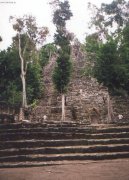| Introduction - Mexico: |
| Location - Mexico: |
| People - Mexico: |
| Government - Mexico: |
| Economy - Mexico: |
Economy overview | Mexico has a free market economy that recently entered the trillion dollar class. It contains a mixture of modern and outmoded industry and agriculture, increasingly dominated by the private sector. Recent administrations have expanded competition in seaports, railroads, telecommunications, electricity generation, natural gas distribution, and airports. Per capita income is one-fourth that of the US; income distribution remains highly unequal. Trade with the US and Canada has tripled since the implementation of NAFTA in 1994. Mexico has 12 free trade agreements with over 40 countries including, Guatemala, Honduras, El Salvador, the European Free Trade Area, and Japan, putting more than 90% of trade under free trade agreements. The new Felipe CALDERON administration that took office in December 2006 faces many of the same challenges that former President FOX tried to tackle, including the need to upgrade infrastructure, modernize the tax system and labor laws, and allow private investment in the energy sector. CALDERON has stated that his top priorities include reducing poverty and creating jobs. The success of his economic agenda will depend on his ability to garner support from the opposition. |
|
Gdp purchasing power parity | $1.149 trillion (2006 est.) |
|
Gdp official exchange rate | $743.5 billion (2006 est.) |
|
Gdp real growth rate | 4.8% (2006 est.) |
|
Gdp per capita ppp | $10,700 (2006 est.) |
|
Gdp composition by sector | agriculture: 3.9%
industry: 25.7%
services: 70.5% (2006 est.) |
|
Labor force | 38.09 million (2006 est.) |
|
Labor force by occupation | agriculture: 18%
industry: 24%
services: 58% (2003) |
|
Unemployment rate | 3.2% plus underemployment of perhaps 25% (2006 est.) |
|
Population below poverty line | 40% (2003 est.) |
|
Household income or consumption by percentage share | lowest 10%: 1.6%
highest 10%: 35.6% (2002) |
|
Distribution of family income gini index | 54.6 (2000) |
|
Inflation rate consumer prices | 3.4% (2006 est.) |
|
Investment gross fixed | 20% of GDP (2006 est.) |
|
Budget | revenues: $196.5 billion
expenditures: $196.2 billion; including capital expenditures of $NA (2006 est.) |
|
Public debt | 20.7% of GDP (2006 est.) |
|
Agriculture products | corn, wheat, soybeans, rice, beans, cotton, coffee, fruit, tomatoes; beef, poultry, dairy products; wood products |
|
Industries | food and beverages, tobacco, chemicals, iron and steel, petroleum, mining, textiles, clothing, motor vehicles, consumer durables, tourism |
|
Industrial production growth rate | 3.6% (2006 est.) |
|
Electricity production | 242.4 billion kWh (2004) |
|
Electricity consumption | 224.6 billion kWh (2004) |
|
Electricity exports | 1.203 billion kWh (2004) |
|
Electricity imports | 416 million kWh (2004) |
|
Oil production | 3.42 million bbl/day (2005 est.) |
|
Oil consumption | 1.97 million bbl/day (2004 est.) |
|
Oil exports | 2.268 million bbl/day (2004) |
|
Oil imports | 308,500 bbl/day (2004) |
|
Oil proved reserves | 12.49 billion bbl (2006 est.) |
|
Natural gas production | 41.47 billion cu m (2004 est.) |
|
Natural gas consumption | 50.45 billion cu m (2004 est.) |
|
Natural gas exports | 0 cu m (2004 est.) |
|
Natural gas imports | 9.831 billion cu m (2004 est.) |
|
Natural gas proved reserves | 420.5 billion cu m (1 January 2005 est.) |
|
Current account balance | -$400.1 million (2006 est.) |
|
Exports | $248.8 billion f.o.b. (2006 est.) |
|
Exports commodities | manufactured goods, oil and oil products, silver, fruits, vegetables, coffee, cotton |
|
Exports partners | US 78.7%, Canada 6%, Spain 1.4% (2006) |
|
Imports | $253.1 billion f.o.b. (2006 est.) |
|
Imports commodities | metalworking machines, steel mill products, agricultural machinery, electrical equipment, car parts for assembly, repair parts for motor vehicles, aircraft, and aircraft parts |
|
Imports partners | US 60%, Japan 4.2%, China 3.9% (2006) |
|
Reserves of foreign exchange and gold | $85.01 billion (2006 est.) |
|
Debt external | $178.3 billion (30 June 2006 est.) |
|
Economic aid recipient | $1.166 billion (1995) |
|
Currency code | Mexican peso (MXN) |
|
Exchange rates | Mexican pesos per US dollar - 10.899 (2006), 10.898 (2005), 11.286 (2004), 10.789 (2003), 9.656 (2002) |
|
| Communications - Mexico: |
| Transportation - Mexico: |
| Military - Mexico: |
This page was last updated on 16 September, 2007



